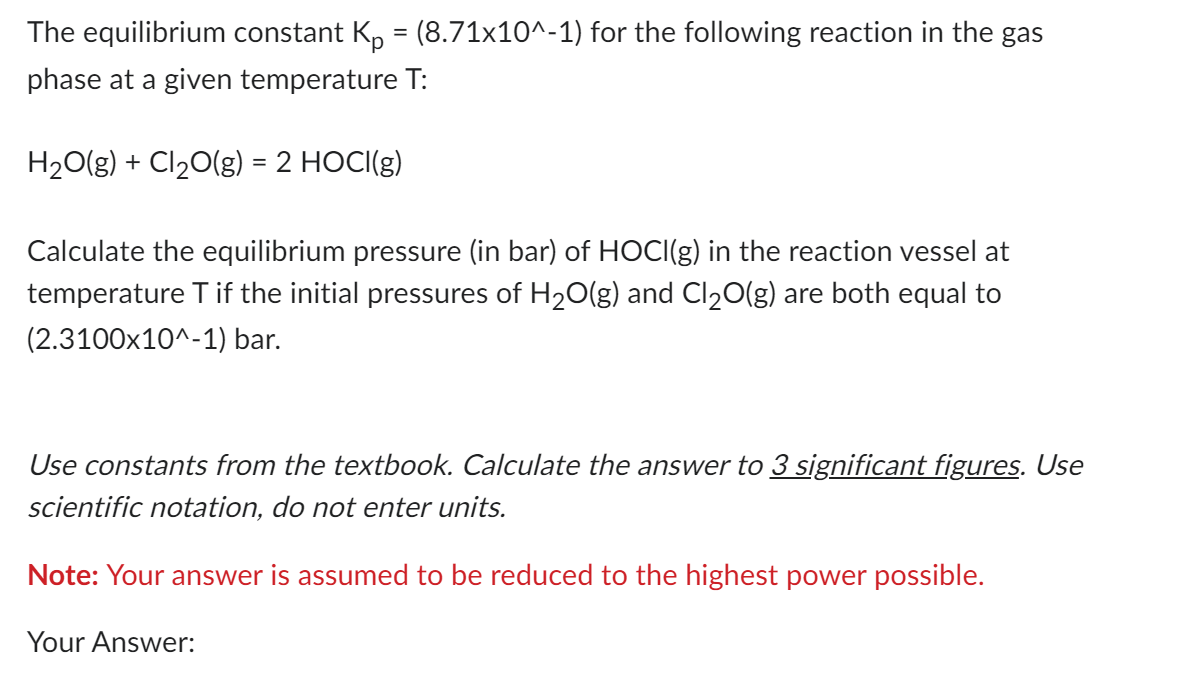The equilibrium constant Kp = (8.71x10^-1) for the following reaction in the gas phase at a given temperature T: H2O(g) + Cl2O(g) = 2 HOCI(g) Calculate the equilibrium pressure (in bar) of HOCI(g) in the reaction vessel at temperature T if the initial pressures of H2O(g) and Cl₂O(g) are both equal to (2.3100x10^-1) bar. Use constants from the textbook. Calculate the answer to 3 significant figures. Use scientific notation, do not enter units. Note: Your answer is assumed to be reduced to the highest power possible. Your Answer:
The equilibrium constant Kp = (8.71x10^-1) for the following reaction in the gas phase at a given temperature T: H2O(g) + Cl2O(g) = 2 HOCI(g) Calculate the equilibrium pressure (in bar) of HOCI(g) in the reaction vessel at temperature T if the initial pressures of H2O(g) and Cl₂O(g) are both equal to (2.3100x10^-1) bar. Use constants from the textbook. Calculate the answer to 3 significant figures. Use scientific notation, do not enter units. Note: Your answer is assumed to be reduced to the highest power possible. Your Answer:
Principles of Modern Chemistry
8th Edition
ISBN:9781305079113
Author:David W. Oxtoby, H. Pat Gillis, Laurie J. Butler
Publisher:David W. Oxtoby, H. Pat Gillis, Laurie J. Butler
Chapter14: Chemical Equilibrium
Section: Chapter Questions
Problem 89AP
Related questions
Question

Transcribed Image Text:The equilibrium constant Kp = (8.71x10^-1) for the following reaction in the gas
phase at a given temperature T:
H2O(g) + Cl2O(g) = 2 HOCI(g)
Calculate the equilibrium pressure (in bar) of HOCI(g) in the reaction vessel at
temperature T if the initial pressures of H2O(g) and Cl₂O(g) are both equal to
(2.3100x10^-1) bar.
Use constants from the textbook. Calculate the answer to 3 significant figures. Use
scientific notation, do not enter units.
Note: Your answer is assumed to be reduced to the highest power possible.
Your Answer:
Expert Solution
This question has been solved!
Explore an expertly crafted, step-by-step solution for a thorough understanding of key concepts.
Step by step
Solved in 3 steps with 2 images

Knowledge Booster
Learn more about
Need a deep-dive on the concept behind this application? Look no further. Learn more about this topic, chemistry and related others by exploring similar questions and additional content below.Recommended textbooks for you

Principles of Modern Chemistry
Chemistry
ISBN:
9781305079113
Author:
David W. Oxtoby, H. Pat Gillis, Laurie J. Butler
Publisher:
Cengage Learning

Chemistry: The Molecular Science
Chemistry
ISBN:
9781285199047
Author:
John W. Moore, Conrad L. Stanitski
Publisher:
Cengage Learning

Chemistry & Chemical Reactivity
Chemistry
ISBN:
9781133949640
Author:
John C. Kotz, Paul M. Treichel, John Townsend, David Treichel
Publisher:
Cengage Learning

Principles of Modern Chemistry
Chemistry
ISBN:
9781305079113
Author:
David W. Oxtoby, H. Pat Gillis, Laurie J. Butler
Publisher:
Cengage Learning

Chemistry: The Molecular Science
Chemistry
ISBN:
9781285199047
Author:
John W. Moore, Conrad L. Stanitski
Publisher:
Cengage Learning

Chemistry & Chemical Reactivity
Chemistry
ISBN:
9781133949640
Author:
John C. Kotz, Paul M. Treichel, John Townsend, David Treichel
Publisher:
Cengage Learning

Chemistry & Chemical Reactivity
Chemistry
ISBN:
9781337399074
Author:
John C. Kotz, Paul M. Treichel, John Townsend, David Treichel
Publisher:
Cengage Learning


Chemistry: An Atoms First Approach
Chemistry
ISBN:
9781305079243
Author:
Steven S. Zumdahl, Susan A. Zumdahl
Publisher:
Cengage Learning